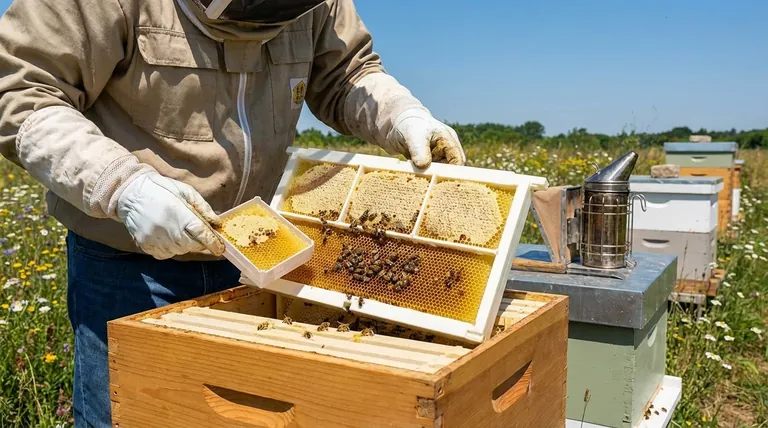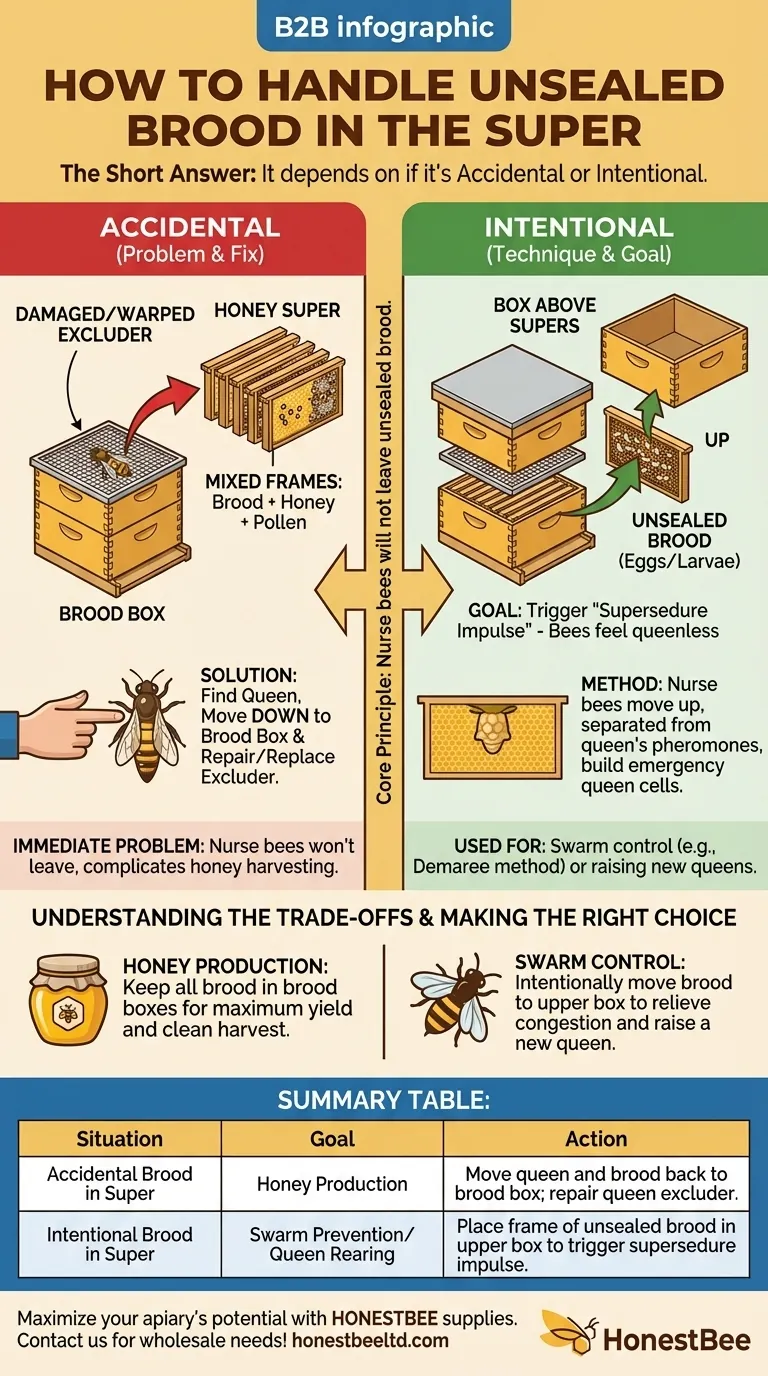The short answer is this: Handling unsealed brood in a honey super depends entirely on whether it is there by accident or by design. If accidental, you must move the brood and the queen back down to the brood box to protect your honey harvest. If intentional, moving unsealed brood into a super is a powerful technique used by advanced beekeepers to prevent swarms or raise new queens.
The core principle is that unsealed brood dictates the location of the brood nest and the behavior of nurse bees. Where the open brood goes, the nurse bees follow. Controlling the location of this brood is therefore fundamental to controlling your hive's objectives, whether that is honey production or colony expansion.

What to Do When the Queen Lays in the Honey Super
The most common reason to find brood in a honey super is that the queen has bypassed the queen excluder. This is a problem you need to correct for effective honey management.
Why This Happens
A queen can move into a honey super if the queen excluder is damaged, warped, or improperly placed, leaving a gap. In hives without an excluder, the queen will naturally move upward as the colony expands.
The Immediate Problem for Honey Production
When brood is present in a honey super, nurse bees will not abandon it. Their biological imperative is to care for the young larvae.
This means you cannot use a bee escape or other methods to clear the bees from the super, making honey harvesting extremely difficult. The frames become a mix of brood, pollen, and nectar, not clean honey.
The Solution: Re-establish the Brood Nest
To fix this, you must find the queen. Carefully inspect the frames in the super until you locate her.
Once found, move the queen and all frames containing brood back down into the designated brood box.
After reorganizing the hive, place a new or repaired queen excluder between the brood box and the honey supers to prevent it from happening again.
Using Unsealed Brood for Advanced Hive Management
In contrast to being an accident, intentionally placing unsealed brood in a super is a specific and powerful technique. This is done to manipulate the colony's natural instincts for specific outcomes.
The Goal: Triggering the "Supersedure Impulse"
The primary goal is to make the bees in the super believe they are queenless. A colony that believes it has no queen will initiate an emergency "supersedure impulse" to raise a new one.
By moving a frame with very young larvae or eggs into a super—separated from the queen by a queen excluder—you create a "queenless" population in that box.
The Method and Why It Works
The technique involves placing the old queen in the bottom-most brood box under a queen excluder. Then, a frame of unsealed brood (with eggs and young larvae) is lifted into a box on top of the supers, well above the excluder.
Nurse bees will immediately move up to cover and care for this brood. Because they are now separated from the queen by several boxes, her pheromones are too faint to reach them. The combination of present larvae and absent queen pheromones triggers them to build emergency queen cells on that frame.
This method is the foundation of swarm control techniques like the Demaree method and is also used to raise new queens without having to make a separate nucleus colony.
Understanding the Trade-offs
Manipulating brood location has significant consequences that you must understand before you begin moving frames.
For Honey Production
Having brood in your honey supers is almost always a negative. You cannot extract honey from frames containing brood, and the presence of nurse bees complicates the entire harvesting process. For maximum honey yield, a strict separation is essential.
For Swarm Control
As a tool for swarm control, intentionally moving brood is highly effective. It relieves congestion in the main brood nest and redirects the bees' energy from swarming to raising a new queen, all within the same hive. However, it requires careful management to ensure the colony remains balanced.
The Critical Role of Nurse Bees
Remember the key principle: nurse bees will not leave unsealed brood. This is a non-negotiable aspect of bee biology. Whether the brood's location is a mistake or a strategy, the behavior of a large portion of your workforce is tied directly to that frame.
Making the Right Choice for Your Goal
Your approach to brood in the super should be dictated by your primary objective for the hive at that moment.
- If your primary focus is honey production: Keep all brood, sealed and unsealed, strictly confined to the brood boxes below a queen excluder.
- If your primary focus is swarm prevention or raising a new queen: Intentionally moving a frame of unsealed brood to an upper box is a cornerstone of advanced hive management.
Mastering hive management comes from understanding how to use the location of brood to direct the colony's powerful natural instincts.
Summary Table:
| Situation | Goal | Action |
|---|---|---|
| Accidental Brood in Super | Honey Production | Move queen and brood back to brood box; repair queen excluder. |
| Intentional Brood in Super | Swarm Prevention/Queen Rearing | Place frame of unsealed brood in upper box to trigger supersedure impulse. |
Maximize your apiary's potential with the right equipment. Whether you're a commercial apiary focused on honey production or a distributor managing advanced hive techniques, HONESTBEE supplies durable, reliable beekeeping supplies and equipment designed for efficiency and success. Let us help you achieve your hive management goals—contact us today to discuss your wholesale needs!
Visual Guide

Related Products
- Professional 500g Sectional Comb Honey Frame System for Beekeeping
- Langstroth Honey Bee Box Hive Boxes for Different Depths
- Australian Langstroth Beehive Boxes for Beekeeping Wholesales
- Portable Bee Mating Hive Boxes Mini Mating Nucs 8 Frames for Queen Rearing
- Twin Queen Styrofoam Honey Bee Nucs Mating and Breeding Box
People Also Ask
- What frame to use for honeycomb? Choose the Right System for Pure, Edible Comb
- Why might a customer look for shallow equipment in a store? To Reduce Weight and Enhance Hive Management
- How do you inspect honey frames? Master the 70-80% Rule for Healthy Hives
- How do bees use Flow Frames? A Guide to Stress-Free Honey Harvesting
- When should I pull my honey supers? Harvest at the Perfect Time for Quality Honey



















